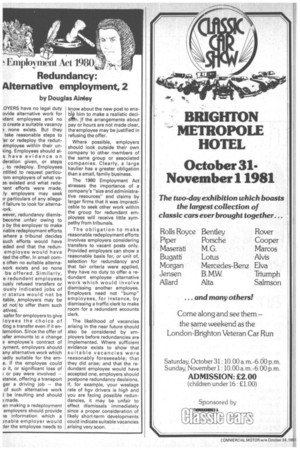Redundancy: Alternative employment, 2
Page 44

If you've noticed an error in this article please click here to report it so we can fix it.
by Douglas Airwley
.0YERS have no legal duty ovide alternative work for idant employees and no :o create a suitable vacancy 3 none exists. But they take reasonable steps to 'er or redeploy the redunemployee within their unking. Employees should als have evidence on deration given, or steps , to redeploy. Employees ntitled to request particu-om employers of what yeas existed and what rede-tent efforts were made. ly employers may seek ?r particulars of any allega
failure to look for alternafork.
rvever, redundancy dismisbecome unfair owing to a by the employer to make nable redeployment efforts where a tribunal decides such efforts would have eded and that the redunemployee would have ted the offer. In small corns often no suitable alternawork exists and so none be offered. Similarly, e redundant employees Dusly refused transfers or ously indicated jobs of
status would not be table, !employers may be ad not/to offer them such atives.
safer for employers to give loyees the choice of rting a transfer even if it enemotion. Since the offer of Isfer amounts to a change a employee's contract of )yment, employers should any alternative work which )adly suitable for the eme. If the employee could o it, or significant loss of ; or pay were involved — stance, offering a transport ger a driving job — the of such alternative work be insulting and should ? made.
en making a redeployment employers should provide -le information which a )nable employer would ler the employee needs to
know about the new post to enaOp him to make a realistic deciSW. )f the arrangements about pay or hours are not made clear, the'employee may be justified in refusing the offer.
Where possible, employers should look outside their own company to other members of the same group or associated companies. Clearly, a large haulier has a greater obligation than a small, family business.
The 1980 Employment Act stresses the importance of a company's "size and administrative resources" and claims by larger firms that it was impracticable to seek other work within the group for redundant employees will receive little sympathy from tribunals.
The obligation to make reasonable redeployment efforts involves employers considering transfers to vacant posts only. Provided employers can show a reasonable basis for, or unit of, selection for redundancy and that fair criteria were applied, they have no duty to offer a redundant employee alternative work which would involve dismissing another employee. Employers need not "bump" employees, for instance, by dismissing a traffic clerk to make room for a redundant accounts clerk.
The likelihood of vacancies arising in the near future should also be considered by employers before redundancies are implemented. Where sufficient evidence exists to show that suitable vacancies were reasonably foreseeable; that they did arise; and that the redundant employee would have accepted one, employers should postpone redundancy decisions. If, for example, your wastage rate of hgv drivers is high and you are facing possible redundancies, it may be unfair to effect dismissals immediately since a proper consideration of likely short-term developments could indicate suitable vacancies arising very soon.














































